Cross-chain Discussion: Differentiated Competition of Cross-chain Aggregators
Author: DODO Research Institute
The term "cross-chain" originates from the fact that in cross-chain transactions, the initial and target assets are deployed on two isolated blockchains, and the execution occurs after traversing two or more independent blockchain networks.
With the congestion of the Ethereum network and high transaction fees, the capital overflow effect has become increasingly evident. The emergence of cross-chain bridges breaks the blockchain islands and is expanding the development of the DeFi ecosystem. Smart capital has the opportunity to shuttle between major public chains, seeking higher-yield "rich mines." However, opportunities come with costs; the expansion of the multi-chain ecosystem, with over 100 cross-chain bridges, has brought a wealth of path choices but also increased the complexity of decisions for users. If you are interested in the performance, classification, and future development trends of mainstream cross-chain bridges, you can check out Dr. DODO's “Cross-Chain Discussion: In-Depth Analysis of 16 Cross-Chain Solutions Trade-offs”.
Cross-chain infrastructure is one of the foundational constructions in building a multi-chain, multi-layer blueprint. Among these, cross-chain aggregators carry the indispensable cross-chain aggregation trading function of the cross-chain universe. Their clear and defined goal is to reduce trading difficulty, using algorithms to determine which path can provide lower transaction costs, which is faster, and which is more secure, thereby optimizing the cross-chain trading path for users.
So besides that, what are the differentiated advantages of cross-chain aggregator products? How do they fulfill asset cross-chain needs? Why are cross-chain aggregators necessary? With these questions in mind, let’s start by examining the existing five cross-chain aggregators, scanning the current landscape of cross-chain aggregators, and interpreting how they expand development dimensions based on asset cross-chain aggregation trading, connecting assets and data, and moving towards a multi-dimensional, multi-chain, multi-layer ecological universe.
Li.Finance
Tags: Cross-chain functionality + Aggregated trading;
Li.Finance (Li.Fi) can be explained in one sentence: it is 1 inch and Paraswap with cross-chain bridge functionality. Under the combination of cross-chain bridges and DEX aggregators, Li.Fi achieves dual functions of cross-chain swapping and cross-chain aggregated trading (Cross-Chain Yield Farming Strategies). It undertakes the on-chain asset cross-chain function of cross-chain bridges. Simply put, you can swap any token from any (supported) chain to another token on a different chain.
However, the cost of this trading process is quite high. Suppose a user wants to exchange ETH from Ethereum for BNB on the BNB chain. In this entire transaction process, the user first needs to exchange ETH for USDC, transfer the asset to the BNB chain via the cross-chain bridge, and then exchange USDC for BNB. The cross-chain bridge fees, gas fees, and other costs incurred by the cross-chain process add up to a significant expense for the user.
Taking the trading path provided by Li.Fi as an example, let’s look at the hidden costs involved. When users confirm this transaction, they face decisions such as: which cross-chain bridge to choose as the cross-chain path; which DEX to select for each step of the transaction; after considering these cost metrics, is there a more efficient, convenient, and cheaper way to trade? Finally, the security of the smart contracts of the cross-chain bridges and DEXs is another consideration.
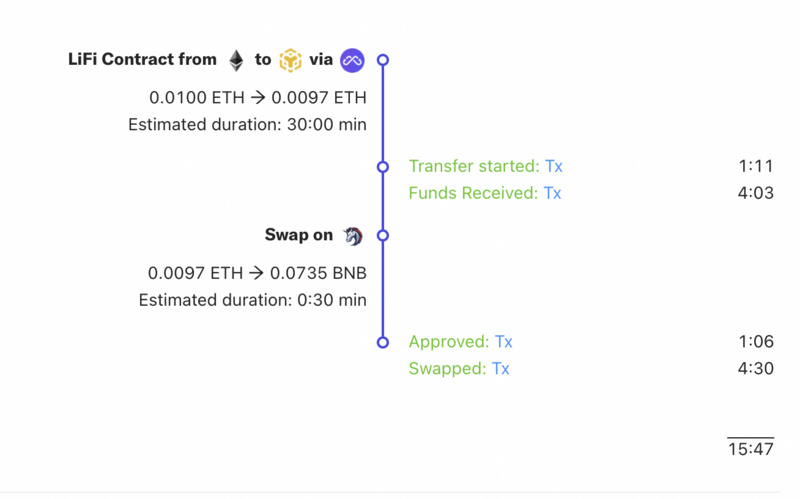
Li.Fi Transaction Process
Li.Fi integrates cross-chain bridge funding resources and links DEXs and DEX aggregators, aiming to break the decision-making difficulties. Upon receiving a user transaction request, Li.Fi automatically evaluates the request's feasibility and scores the path based on multiple indicators such as safety and speed, providing an optimal path.
Reflected at the user level, the entire process is: input the transaction, wait a few seconds, receive a method for fund transfer and exchange, review the transaction process, and after several signature confirmations for cross-chain and fund swaps, complete the transaction. In terms of slippage fee settings, cross-chain bridge, and DEX solution choices, Li.Fi also provides users with a high degree of freedom. By reducing the "choice" cost for users, Li.Fi offers a more efficient utilization of funds.
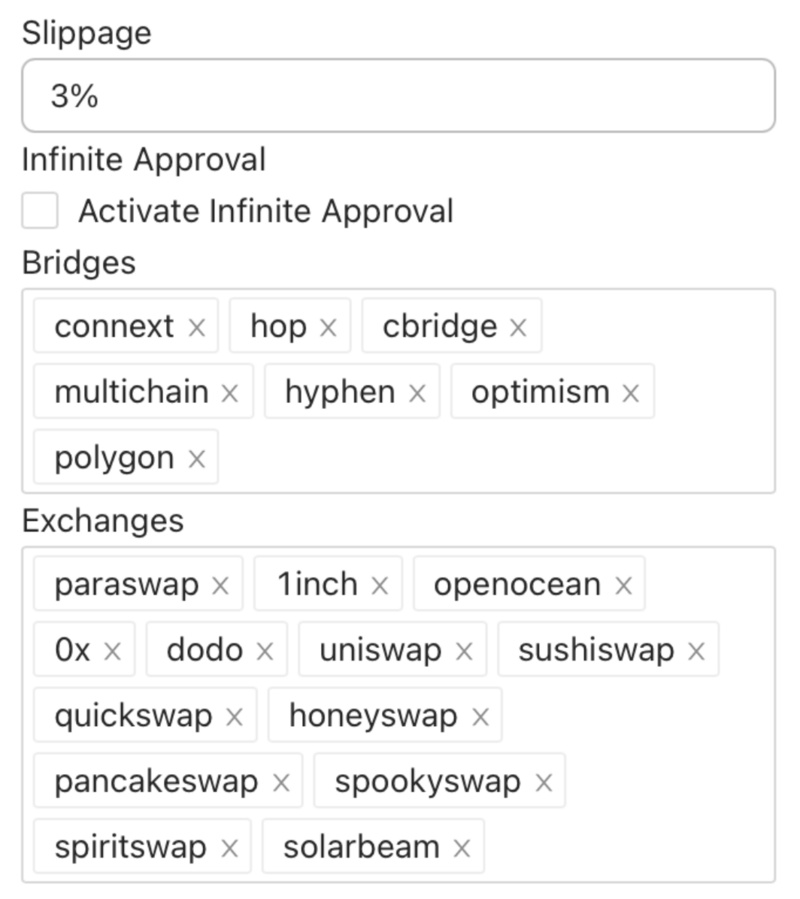
Li.Fi Custom Options When Placing Orders
Compared to cross-chain bridges, Li.Fi highlights the following advantages of cross-chain aggregators:
More diverse cross-chain trading paths: Currently, cross-chain bridges only support stablecoins and relatively singular native assets, often failing to meet users' asset cross-chain trading needs. The roles of DEXs and DEX aggregators cannot be overlooked in the asset cross-chain trading process. Li.Fi integrates cross-chain bridges, DEXs, and DEX aggregators, providing DEXs for token swaps on both the source and target chains, thus broadening the range of cross-chain token exchanges and increasing the likelihood of successful trading paths.
Breaking the liquidity deadlock, further enhancing capital efficiency: Currently, DEXs have multiple identical paired liquidity pool replicas deployed on each public chain. If we multiply the number of liquidity pool replicas by the number of different AMMs on each chain, we find a very inefficient and fragmented system. Cross-chain aggregators create deeper liquidity pools by integrating trading data from other platforms within the same ecosystem, solving the existing inefficiencies and fragmentation.
Optimizing trading security leads to more effective trading paths: When integrating with partners such as cross-chain bridges and DEXs, Li.Fi first conducts technical assessments and reviews internally, which reduces certain "systemic risks" related to smart contract security; secondly, Li.Fi employs Connext technology at its core and uses algorithms to score various factors affecting the safety, gas fees, and speed of each path, providing a smoother optimal trading route.
The functions of aggregators go beyond bridging. The essential function of cross-chain aggregators is cross-chain + aggregated trading, connecting financial attributes such as liquidity mining and lending through asset swaps, allowing users to pool liquidity from different ecosystems. This is a fundamental component of the multi-chain world. Cross-chain aggregation not only enhances capital efficiency but also serves as another solution for on-chain liquidity management. Currently, Li.Fi's asset liquidity relies on external channels; in other words, the integrated public chains, DEXs, and DEX aggregators are core elements that provide advantages for cross-chain path trading. In a sense, we believe Li.Fi has opened a door to the world of cross-chain aggregators. After all, compared to the other four aggregators, it precisely focuses on the cross-chain aggregation trading track.
In the choice between security and decentralization, Li.Fi clearly leans towards the latter. The algorithmic evaluation criteria for determining the optimal path have never been disclosed, and what users know is the best path after a "centralized evaluation." Additionally, while Li.Fi's smart contracts are open-source, the API interface is not. Li.Fi's backend interface has two "killer" termination switches. One is at the API level, where path calculations will directly ignore cross-chain bridges that are under attack or at "danger" levels; the second is at the smart contract level, where if the protocol party encounters a hacker attack, Li.Fi or the project party can shut down the integration interface.
The centralized approach of cross-chain aggregation measures aims to resist hacker attacks with higher smart contract security, but using cross-chain aggregator protocols also means increased counterparty risk. On March 20, 2022, due to a vulnerability in Li.Fi's contract's Swap function, hackers stole approximately $600,000 worth of tokens from 29 wallets. However, it is worth noting that Li.Fi is not the only cross-chain aggregator that has been hacked.
XY Finance
Tags: X swap + Y pool, linking the metaverse
The project feature of XY Finance is the dual functionality of X Swap and Y Pool. X Swap in XY Finance undertakes responsibilities similar to Li.Fi, namely cross-chain swapping and aggregated trading functions. When a user issues a transaction request, XY Finance will create a single transaction from the source chain to the target chain, seeking the optimal effective path, with the transaction's security relying on a decentralized consensus mechanism.
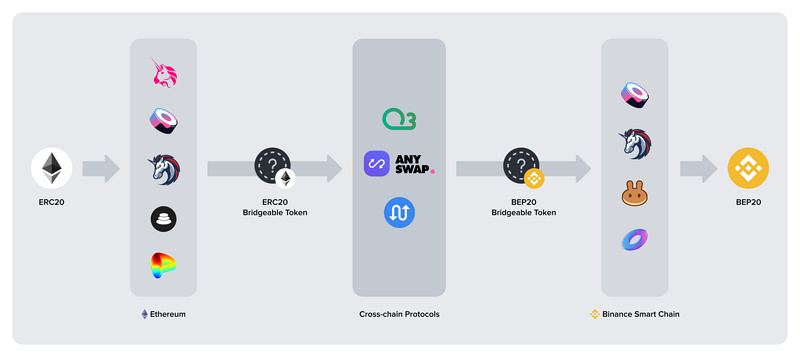
XY Finance Cross-Chain Trading Path
The Y Pool of XY Finance is an upgrade to asset liquidity, forming a difference in liquidity management compared to Li.Fi. The Y Pool is a single-coin liquidity management pool, meaning one pool manages the liquidity of the same asset across multiple chains. Currently, the tokens supported by Y Pool are USDT and USDC.
For example, the USDT Y Pool can accept ERC-20 USDT, BEP-20 USDT, Polygon USDT, and other USDT assets from various chains. Users can deposit ERC20 USDT, BEP20 USDT, and Polygon USDT into the USDT Y Pool to receive pool tokens xyUSDT. These different USDT will be used to provide liquidity for X Swap. Holders of xyUSDT can earn Swap fees generated by X Swap and receive XY tokens as rewards by staking xyUSDT.
The trading demand may significantly shift most liquidity to another chain, causing an imbalance in the asset proportions within the pool. Therefore, XY Finance introduces a rebalancing incentive mechanism. Users can call the Rebalance function to rebalance the liquidity on each chain within the Y Pool, and users who help rebalance the liquidity in the pool can also earn XY token rewards.
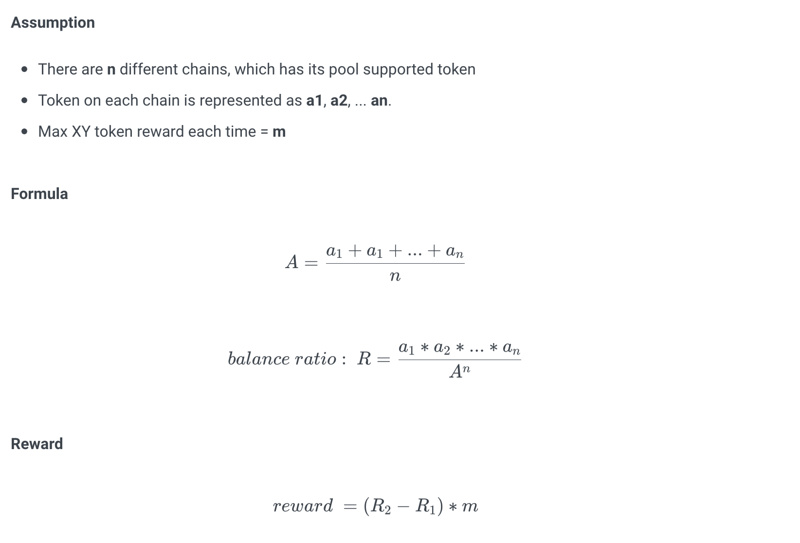
XY Finance Rebalancing Incentive Formula
Assuming that the asset proportions in the USDT Y Pool are unbalanced, with Ethereum USDT at 0.1M, BSC USDT at 10M, and Polygon USDT at 50M:
1) Alice chooses to call the Rebalance function, transferring 20M USDT from Polygon to the Ethereum pool, resulting in balances of: Ethereum: 20.1M, BSC: 10M, Polygon: 30M;
2) According to the formula, the balance ratio (Balance ratio) is R2 = 0.75 = 75%;
3) Assuming the maximum XY token reward amount (m) is 1000; Alice's final reward will be (0.75 - 0.0062) * 1000 = 748.3 XY tokens.
4) The USDT Y Pool will rebalance the proportions of USDT across different chains in the pool according to the algorithm formula.
The mechanisms of X Swap and Y Pool essentially manage liquidity across different chains and incentivize users to become liquidity providers and balancers for on-chain assets. Y Pool creates its own liquidity pool to meet the trading needs of X Swap, while the trading fees from X Swap subsidize the liquidity providers of Y Pool.
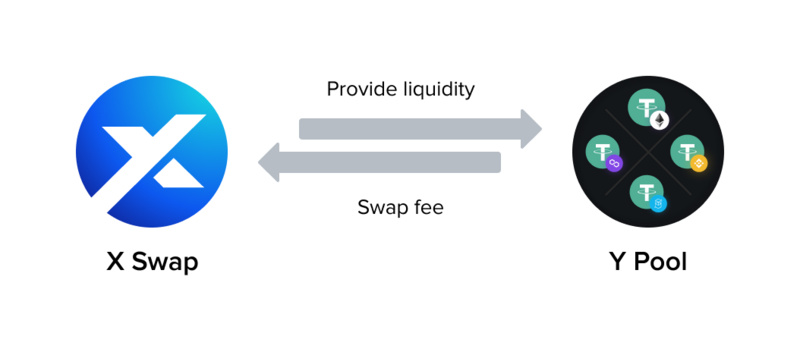
Complementary Mechanism of X Swap and Y Pool
Although XY Finance does not allow for customizable slippage fees and charges users, XY Finance users can still choose the path they consider most suitable for trading based on their needs and preferences after understanding the cross-chain exchange paths.
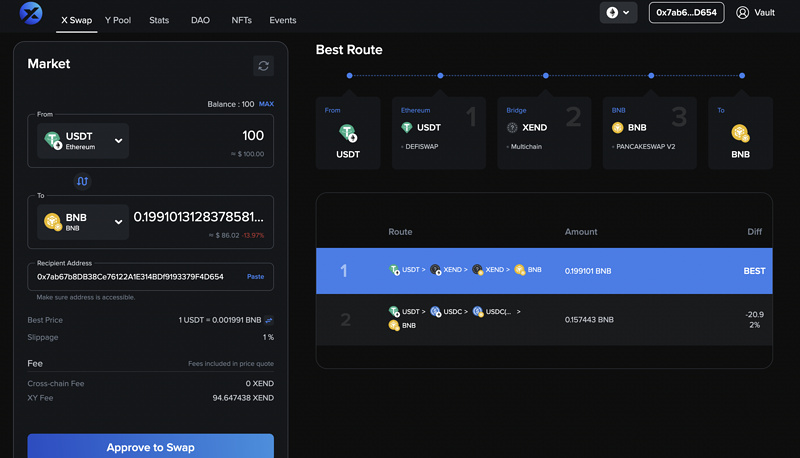
XY Finance Trading Interface
Another core aspect of XY Finance is the XY Token (XY Token). XY is the native token of XY Finance, while veXY is a typical ve-Model token. By staking, XY token holders can participate in various governance proposals, and locking XY will increase liquidity mining rewards, with longer lock times yielding higher rewards.
Overall, X Swap and Y Pool establish a complete cross-chain exchange mechanism for XY Finance, and with the governance token XY, they incentivize users to provide liquidity while binding users' long-term interests with the protocol. In addition, the Play-to-Earn game GalaXY Kats and the NFT aggregation platform NFT Satellite demonstrate XY Finance's ambition to link the metaverse and expand financial services.
O3 Swap
Tags: Four-layer architecture, one-stop trading
A similar cross-chain trading aggregator to XY Finance is O3 Swap. O3 Swap was created by O3 Labs in 2017 and is based on the PolyNetwork cross-chain aggregation protocol. The core functional modules of O3 Swap are O3 Aggregator and O3 Hub, which together provide cross-chain aggregation trading services. O3 Aggregator acts as the trading aggregator, responsible for integrating DEXs across different chains; O3 Hub is the liquidity hub for cross-chain trading, supporting users in providing on-chain asset liquidity.
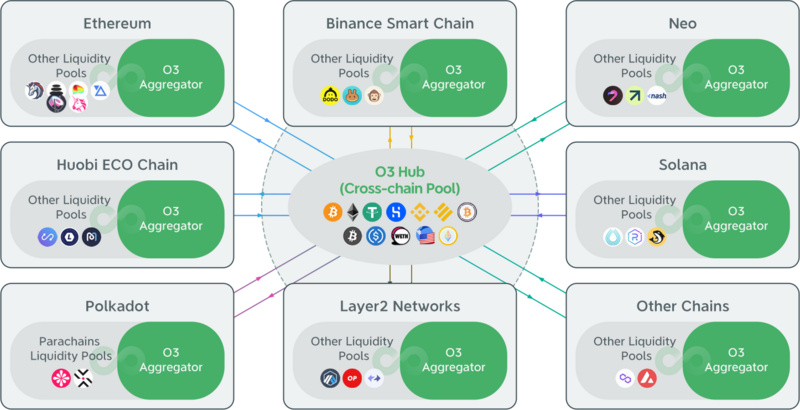
O3 Hub Architecture
Similar to XY Finance's Y Pool, liquidity providers can deposit a single or multiple assets on different chains into O3 Hub, earning O3 tokens as rewards by staking LP tokens, and currently, O3 Hub offers a significantly wider range of choices.
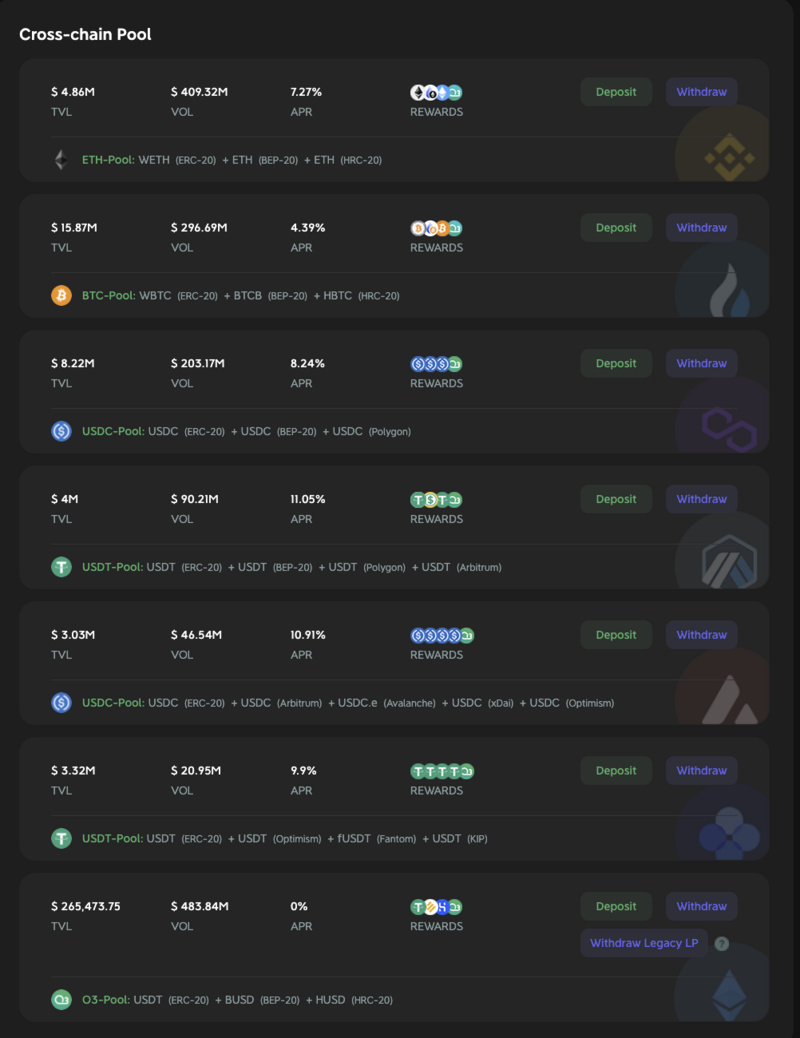
O3 Hub Cross-chain Pool
It is clear that O3 Swap has the basic functions of a cross-chain aggregator, namely liquidity aggregation and cross-chain swapping; combined with the issuance of O3 Swap Tokens, decentralized governance and community-driven development paths are clearly defined. However, these two points alone do not allow O3 Swap to engage in highly differentiated competition with XY Finance. So what is unique about O3 Swap?
First is its four-layer architecture design. The newly announced O3 Swap V2 (O3 Interchange) version showcases O3 Labs' ambition to create a one-stop cross-chain trading platform.
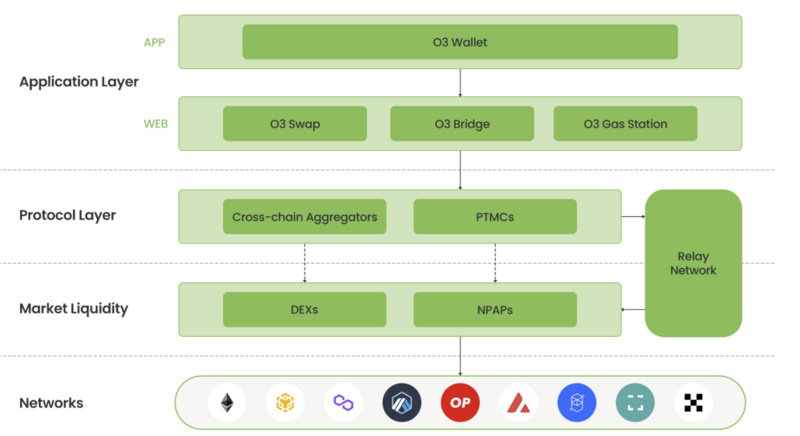
O3 Swap V2 Version Design
The V2 design is more complex. O3 Swap is responsible for aggregating DEXs and DEX aggregators on both the source and target chains, bringing more diverse token choices for cross-chain swapping. O3 Bridge consists of two parts: protocol-layer PTMCs (Pegged Token Management Contracts) and liquidity-layer NPAPs pools (nativeToken & peggedToken AMM Pools), which serve as a cross-chain asset trading channel. In addition to one-click trading, users can also purchase gas fees for transactions at the O3 Gas Station. The horizontally expanded product line enhances the playability of the application, providing users with a one-stop trading experience.
Secondly, the liquidity layer of the V2 version has made further breakthroughs. The liquidity layer consists of two parts: one is the DEX integrated by O3 Aggregator, similar to Li.Fi. DEXs like SushiSwap and PancakeSwap will take on the responsibilities of same-chain swapping. The other is O3's unique NPAPs pool, which is an AMM pool composed of tokens and pegged tokens (pToken) based on a burn-mint mechanism. Tokens enter from the Liquidity Entry Chain, and users can mint an equal amount of pTokens on the liquidity entry chain or other chains. Each pToken on each chain corresponds to an independent PTMC running on PolyNetwork.
It is noteworthy that liquidity providers have two trading modes. The first is Peg, where users peg tokens on the liquidity entry chain or other chains to obtain pTokens; conversely, users can unpeg pTokens back to the liquidity entry chain to redeem tokens. The other trading mode is Barter, where users directly exchange tokens and pTokens within the same chain's AMM pool.
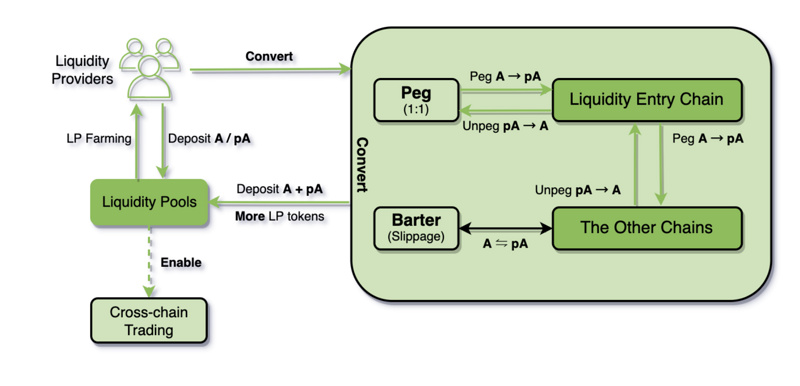
O3 V2 Version Liquidity Solution
In the AMM pool, the initial ratio of Token:pToken is 1:1. However, as users engage in Barter trading for arbitrage, the balance within the pool will be disrupted. Yet, the users' arbitrage actions become a means to adjust the balance of the O3 liquidity pool.
1) Assume the liquidity entry chain for Token A is the Ethereum mainnet, and at this moment, the quantity of Token A in the pool is greater than that of pA;
2) Subsequently, users find that the quantity of Token A in the BNB chain pool (m) is less than that of pA (n);
3) Users choose to exchange m Token A for n pA, then unpeg n pA from the Ethereum mainnet to obtain n Token A;
4) The Ethereum and BNB pools will rebalance again, and the user's arbitrage profit will be (n-m) * Token A.
Clearly, the V2 version's mechanism design is more complex, and significant improvements and optimizations have been made to the liquidity layer, further amplifying O3 Swap's unique one-stop aggregation trading advantage.
ChainSwap
Tags: Asset, data, application cross-chain system
At this point, it is clear that the cross-chain aggregation business is the support point for XY Finance and O3 Swap in the multi-chain universe. ChainSwap is no different. However, beyond multi-chain and multi-asset cross-chain aggregation, ChainSwap aims to build a massive cross-chain ecological hub - ChainSwap Hub.
From assets to applications, from proxy networks to intermediate chains supporting cross-chain functionalities, ChainSwap's four pillars support a comprehensive cross-chain ecosystem.
The asset cross-chain aggregation business is managed by the ChainSwap Bridge Aggregator. Like other cross-chain aggregators, the API interface integrates various cross-chain solutions (currently supporting AnySwap, PolyNetwork, Wormhole, and cBridge) data and backend work, and integration with Rango (a multi-chain DEX aggregator) reveals that ChainSwap is empowering various applications, creating a smart center.
Of course, from a UI design perspective, ChainSwap is closer to the DEX product Uniswap.
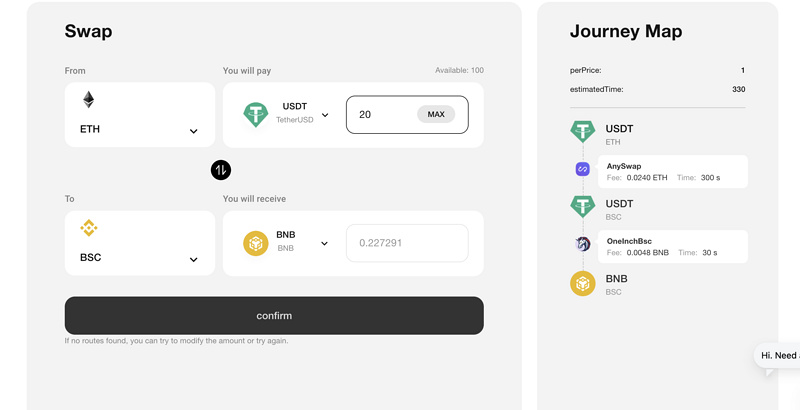
ChainSwap UI Interface
Another function of the ChainSwap Bridge Aggregator is to gather ChainSwap's native projects, such as ChainSwap native bridge V2, which can optimize management processes and improve listing efficiency through its pre-set decentralized listing model. Additionally, according to ChainSwap's documentation, they plan to create a Liquidity Bridge, which uses a "burn-mint" mechanism to provide cross-chain services for mainstream assets, supporting liquidity providers to stake a single token for cross-chain bridges.
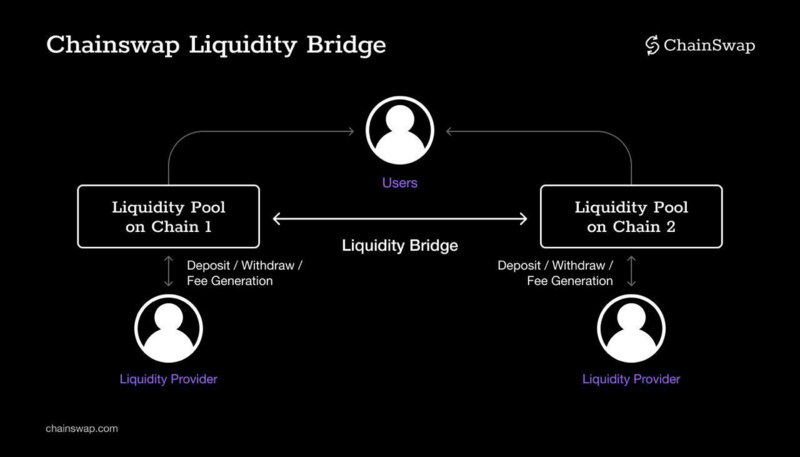
Currently, we believe that the difference between ChainSwap and XY Finance and O3 Swap lies in its choice to start with the native project of cross-chain bridges to address the significant obstacle of insufficient liquidity on the asset side. After all, looking back at its ultimate goal - ChainSwap Hub, ChainSwap aggregates numerous public chains and on-chain dApps such as cross-chain aggregators, cross-chain DEXs, NFT cross-chain applications (to connect lending, derivatives trading, etc. from the asset and data levels), ultimately presenting an intelligent platform that integrates various applications and tools for cross-chain, providing users with a parallel hub for one-click access and multi-chain trading.
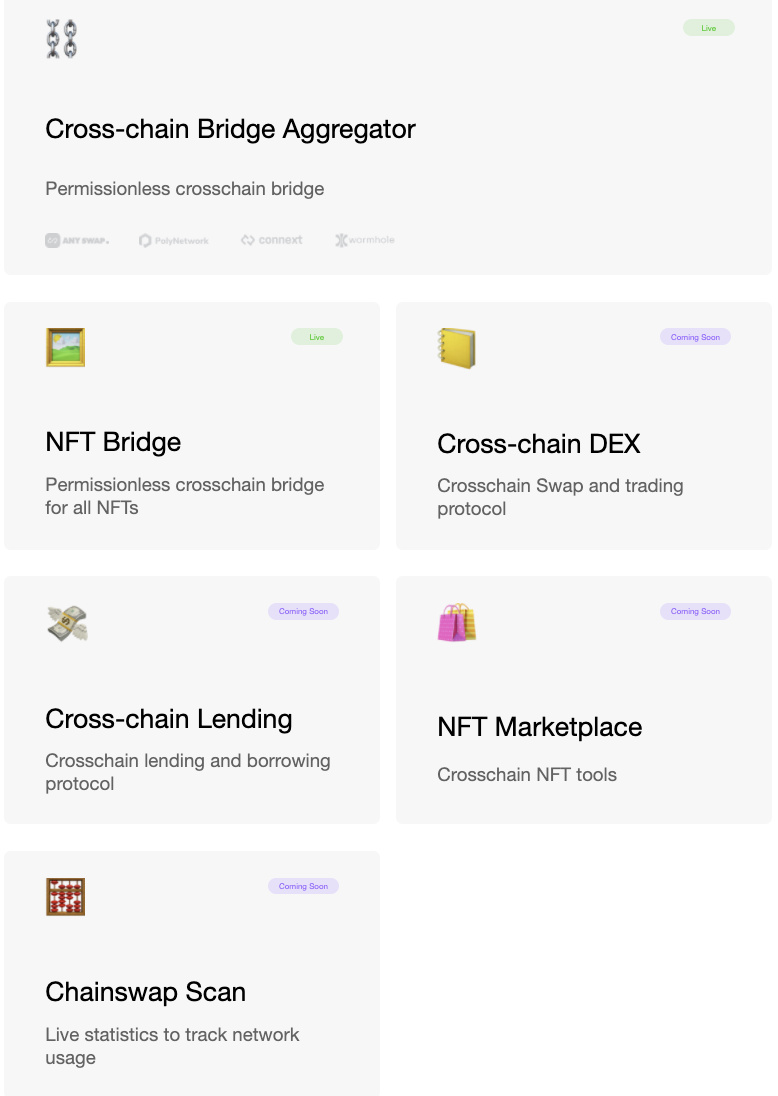
ChainSwap Business Landscape
Bungee
Tags: Peer-to-peer settlement, cross-chain communication protocol
FundMovr completed its rebranding to Bungee in February this year. The business route is quite simple, merely leveraging the advantages of cross-chain aggregators to aggregate cross-chain bridges, DEXs, and DEX aggregators, finding usable routes based on factors such as maximum output on the target chain, minimum gas fees for transactions and transfers, and the fastest bridging time, to meet users' asset cross-chain requirements.
In terms of user experience, one advantage of Bungee is that it lists three types of applicable routes for users. Compared to other cross-chain aggregators, the choice of paths truly returns to the users. You can choose any of the three paths based on your personal preferences: the fastest, the lowest gas fee, or the highest return. Like Li.Fi, Bungee currently does not charge fees.
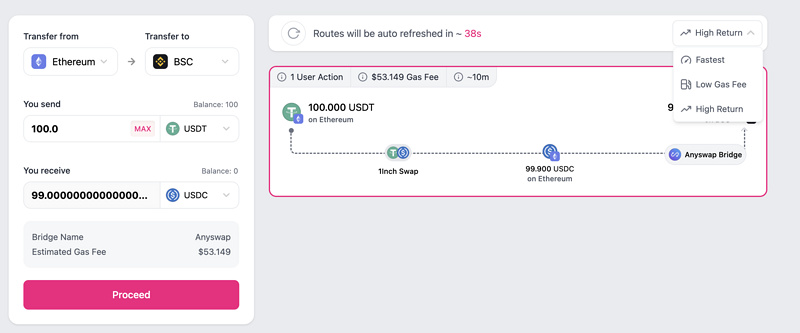
Bungee Trading Interface
When implementing asset cross-chain trading, Bungee adds a peer-to-peer settlement model based on Li.Fi. For example, suppose Alice wants to transfer 100 DAI from Optimism to Arbitrum, and Bob wants to transfer 50 DAI from Arbitrum to Optimism. Bungee will settle DAI in a manner similar to an order book, only needing to transfer the remaining 50 DAI from Alice's transaction from Optimism to Arbitrum. This approach maximizes the efficiency of liquidity pools and is a highly cost-effective choice. However, it also poses a challenge to liquidity depth; if on-chain trading volume is insufficient, this model cannot leverage its advantages.
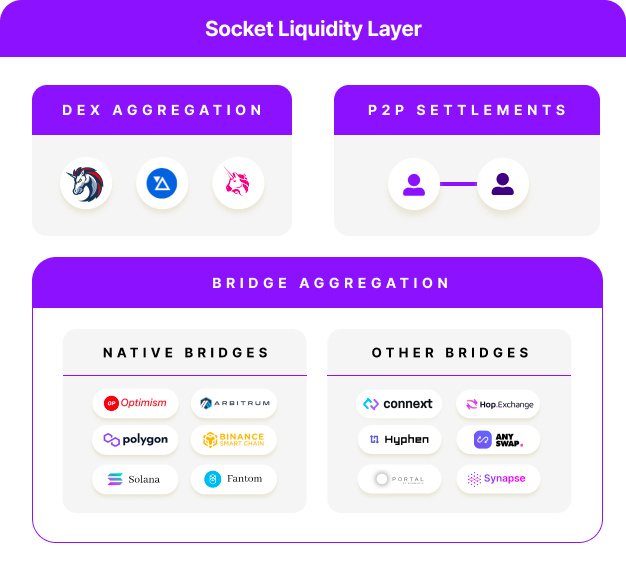
Socket Liquidity Layer Distribution
As a new project still in the testing phase, Bungee has limited path choices and insufficient liquidity depth. Setting this aside, let’s look at the deeper business logic of Bungee behind its team, Socket.
Socket approaches the multi-chain ecosystem from a technical perspective. It creates a metalayer to achieve shared liquidity and unified dApp states across chains. Protocols can integrate API interfaces to accomplish seamless bidirectional transmission of cross-chain assets and information. Currently, foundational projects like Zapper, Zerion, and Ambire Wallet are supported by Socket API. Developers can also use Socket as a foundational technical architecture layer, customizing optimizations to build interoperable dApps.
In our view, Bungee, as a native project of the Socket team, is essentially a demonstration of the team's core technology output, a brand example, and a starting point for opening cross-chain communication protocols.
At this point, we have completed the explanation of the business implementation methods and core elements of these five cross-chain aggregators. Next, let’s provide a brief overview of the project progress of these five cross-chain aggregators based on currently supported public chains/DEXs/DEX aggregators, differences in trading functions, user experiences, and other factors.
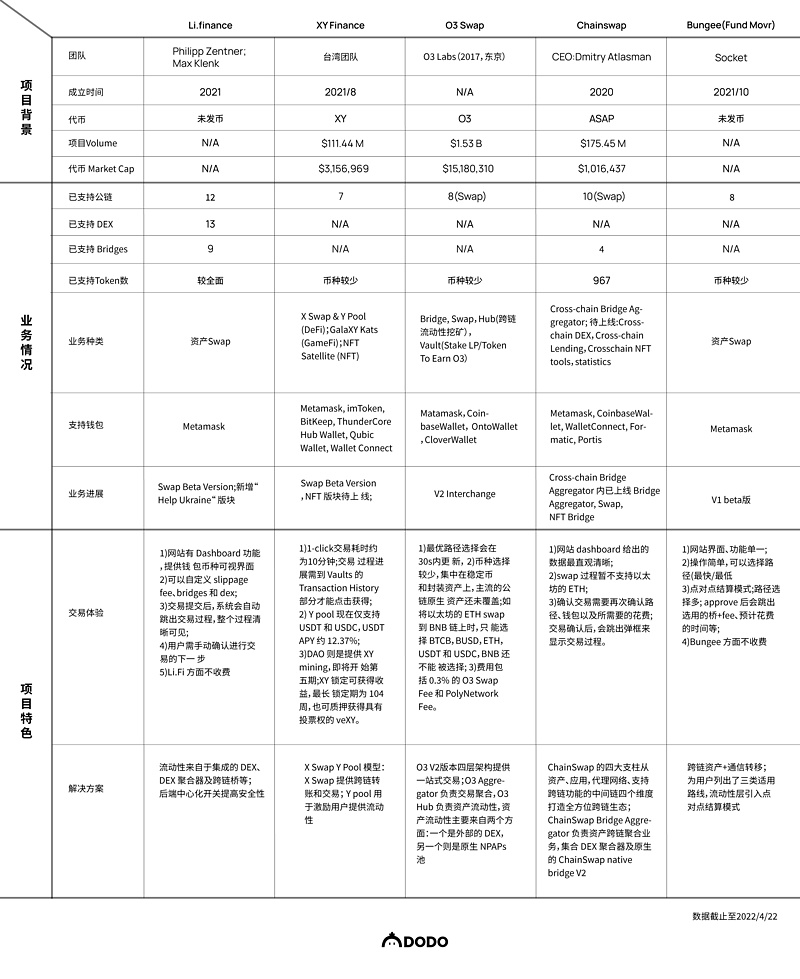
Data as of 2022/4/22
The product comparison table can also be viewed by clicking the Google Docs link.
Returning to another question posed at the beginning: Why are cross-chain aggregators necessary? We summarize several key points as follows:
1) Efficient liquidity makes the transaction costs of cross-chain aggregators lower.
Cross-chain bridges have a single function, only responsible for the back-and-forth "transport" of stablecoins and native tokens, and the lack of composability fails to meet users' actual needs. When cross-chain bridges use wrapped assets as intermediate tokens to solve liquidity issues, the increased complexity of transactions translates to unnecessary expenses and poor user experiences. More importantly, when users compare the advantages and disadvantages of various cross-chain bridges and DEXs, they are incurring redundant and inefficient work costs.
2) The user experience of cross-chain aggregators is superior.
Cross-chain aggregators aggregate cross-chain bridges, connect DEXs and DEX aggregators, shortening the time required to query token exchange paths, allowing users to choose any method for the entire asset exchange process. For users, cross-chain aggregators have significantly improved usability, convenience, and capital efficiency. They can aggregate all cross-chain bridges, DEXs, and DEX aggregators, find all available routes, and help users move funds between different blockchains using the optimal path based on factors such as maximum output on the destination chain, minimum gas fees for transactions and transfers, and minimum bridging time.
3) Cross-chain aggregators reduce development, decision-making, and management costs.
The development of cross-chain bridges is still immature, which means security risks, insufficient liquidity, and high maintenance costs. As a third party, cross-chain aggregators maintain the bridging functions of all cooperating cross-chain bridges and programmatically handle user decisions. For technical developers, cross-chain aggregators serve as a "backup" solution.
4) The business of cross-chain aggregators is not limited to asset cross-chain.
Cross-chain aggregators do not only point to the liquidity aggregation and aggregated cross-chain bridge protocols required for asset cross-chain; XY Finance and O3 Swap may link to the metaverse or create a one-stop trading platform, while ChainSwap and Bungee extend their reach to data and application cross-chain communication. The issuance of tokens by XY Finance and O3 Swap, besides rewarding liquidity providers, also indicates that decentralized governance and community-driven models are developing.
5) Bidirectional transmission of assets and information makes cross-chain aggregators an important component of the multi-chain universe.
Taking Web 2 as an example, cross-chain aggregators are akin to bridge-like shopping sites, serving as small components in the multi-chain ecosystem. They break down barriers to seamless bidirectional transmission of assets and information, creating a more flexible user experience. Limiting cross-chain aggregators solely to the asset cross-chain aspect is too narrow; they are more like a functional key.
Whether from a technical perspective, focusing on cross-chain aggregation trading, or using it as a starting point for business expansion, the aim is to open the door to the multi-chain trading universe. It is important to note that the DeFi world is immensely powerful, and asset efficiency is the most intuitive and straightforward core demand of users; asset cross-chain is the most lucrative piece of meat.
As mentioned in the introduction, the advantages of cross-chain aggregators in fulfilling users' asset conversion needs are quite evident. Conveniently trading popular assets, simplified trading steps, significantly reduced transaction costs, and efficient capital utilization can lock in a non-technical user profile. However, the pain points of early cross-chain aggregators are also quite apparent. Incomplete functions and insufficient liquidity lead to poor user experiences. One major reason users utilize cross-chain aggregators is to improve trading efficiency. Yet, when submitting a transaction request with the mindset of quick success, they often find it challenging to locate a suitable trading path, amplifying feelings of disappointment.
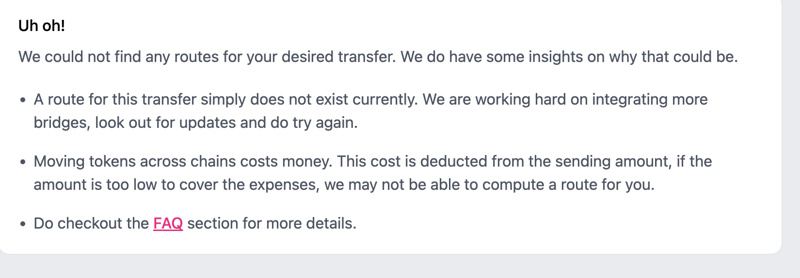
This is a prompt that appears when attempting to swap Ethereum's USDT for BNB on Bungee, but the inability to confirm the trading path is not exclusive to Bungee.
The cross-chain bridge track is being reshaped, broadening possibilities. The emergence of popular projects like Layerzero breaks the current deadlock of cross-chain bridges from the underlying architecture, while the appearance of cross-chain comparison tools like BridgeEye is improving cross-chain infrastructure. New projects such as THORSwap, a cross-chain DEX based on THORChain (which Ryan Watkins describes as a decentralized cross-chain liquidity protocol that can replace exchanges and custodians), and SwimProtocol, which combines Wormhole bridging technology with AMM mechanisms, are also providing fresh development ideas for breaking blockchain islands with cross-chain liquidity.
How to manage on-chain liquidity is an unavoidable topic for the future development of cross-chain aggregators. Currently, Li.Finance chooses to source liquidity externally, while XY Finance and O3 Swap opt to create native liquidity pools. ChainSwap and Bungee, the former refining native cross-chain bridges to enhance token supply, and the latter adopting peer-to-peer settlement to improve capital efficiency.
On the other hand, the four cross-chain aggregators, excluding Li.Finance, are exploring the composability of cross-chain liquidity through cross-chain aggregation trading. Ultimately, cross-chain aggregation trading is a direction for the future development of capital efficiency and on-chain liquidity management in the DeFi world, but it is not the only one. Its development complements the growth of DeFi.
In our view, as more public chain ecosystems emerge and multi-chain becomes possible, cross-chain aggregation trading is likely to become a routine business in the DeFi ecosystem, while DeFi's exploration of on-chain liquidity, such as cross-chain liquidity mining incentive policies, "active market maker" trading mechanisms, and LaaS (Liquidity as a Service) trends, may inspire future directions for cross-chain aggregation development.
At the same time, hacker incidents caused by contract vulnerabilities are occurring frequently. In addition to the previously mentioned Li.Fi, ChainSwap and O3 Swap have also faced varying degrees of similar impacts.
On July 10, 2021, ChainSwap was hacked, resulting in a theft of $8 million; on August 1, 2021, due to a breach of the underlying protocol Poly Network, $610 million was stolen, and the liquidity funds locked in O3 Swap also suffered significant losses. As we look ahead to future development paths, we find that effectively preventing security vulnerability attacks is one of the urgent issues that cross-chain aggregators need to address.










